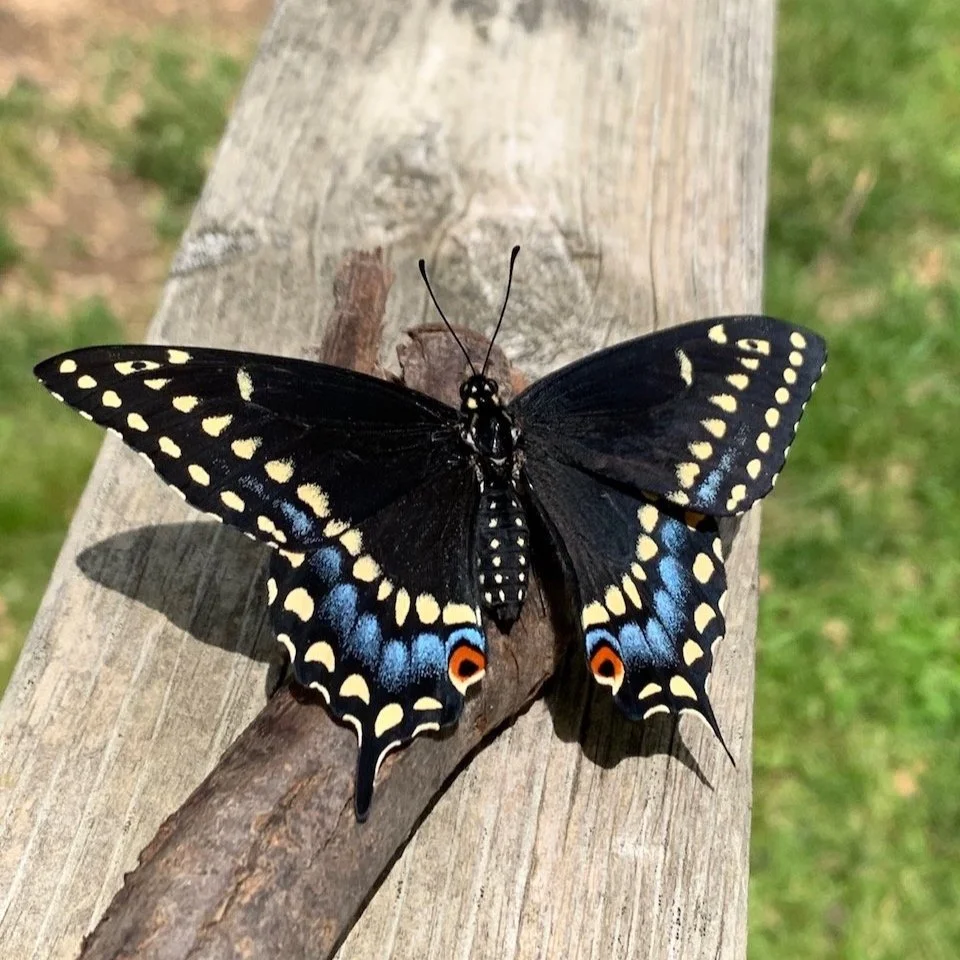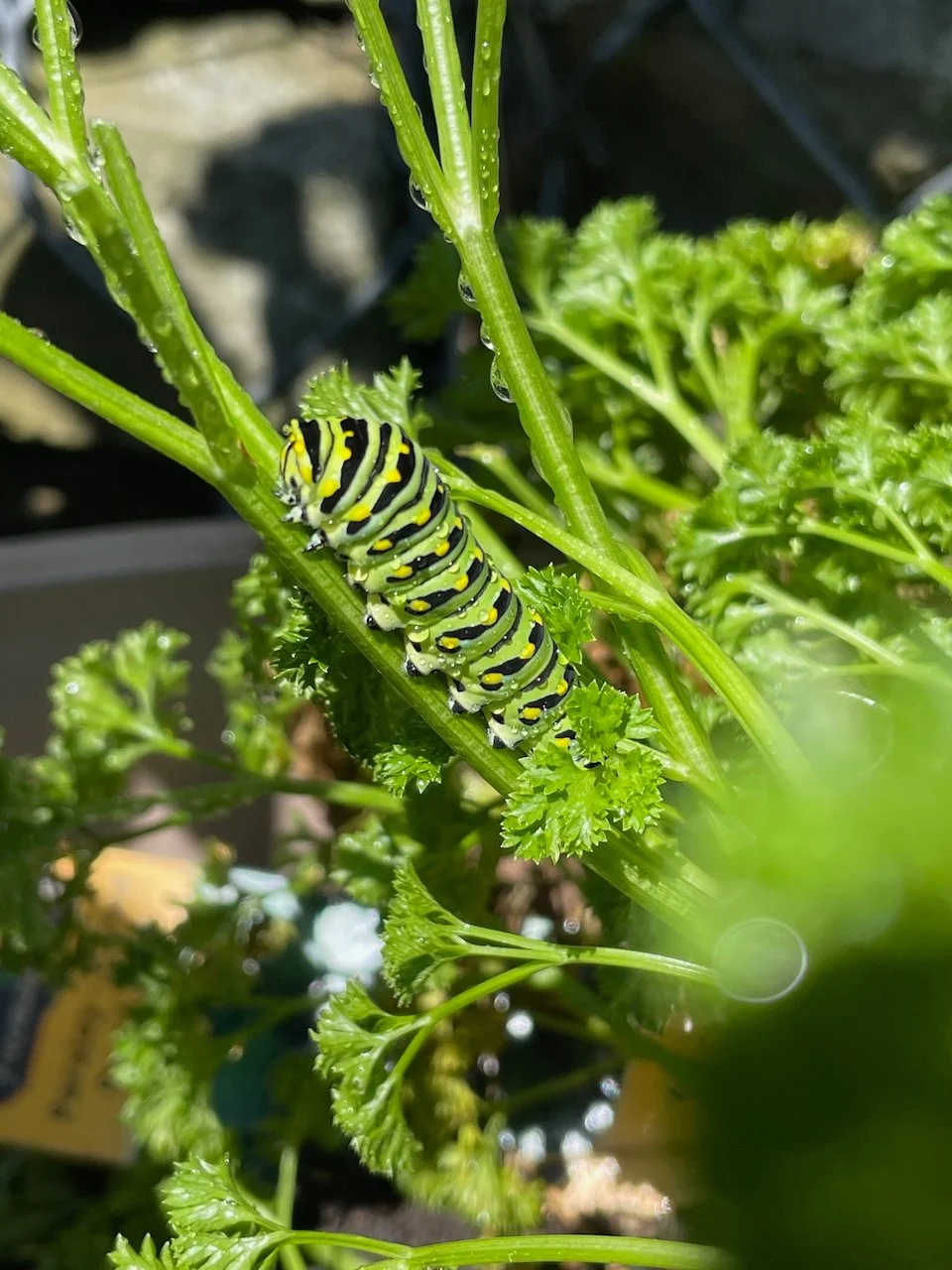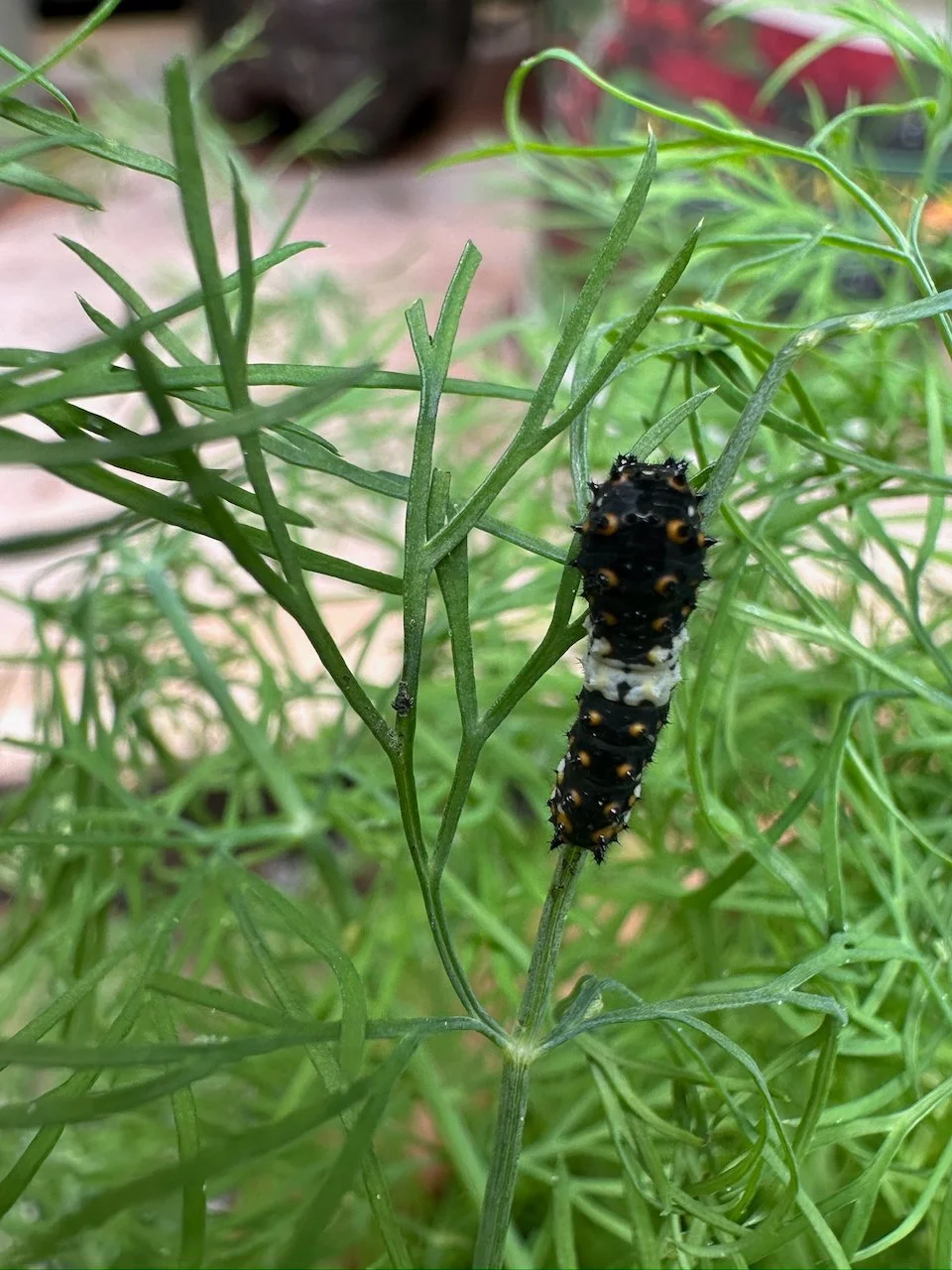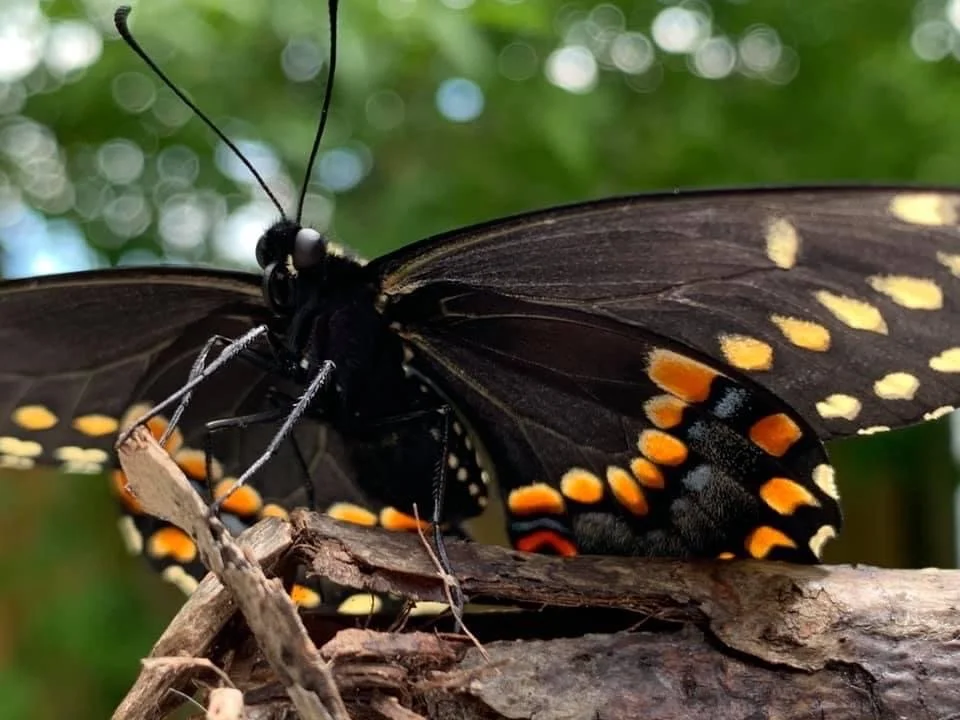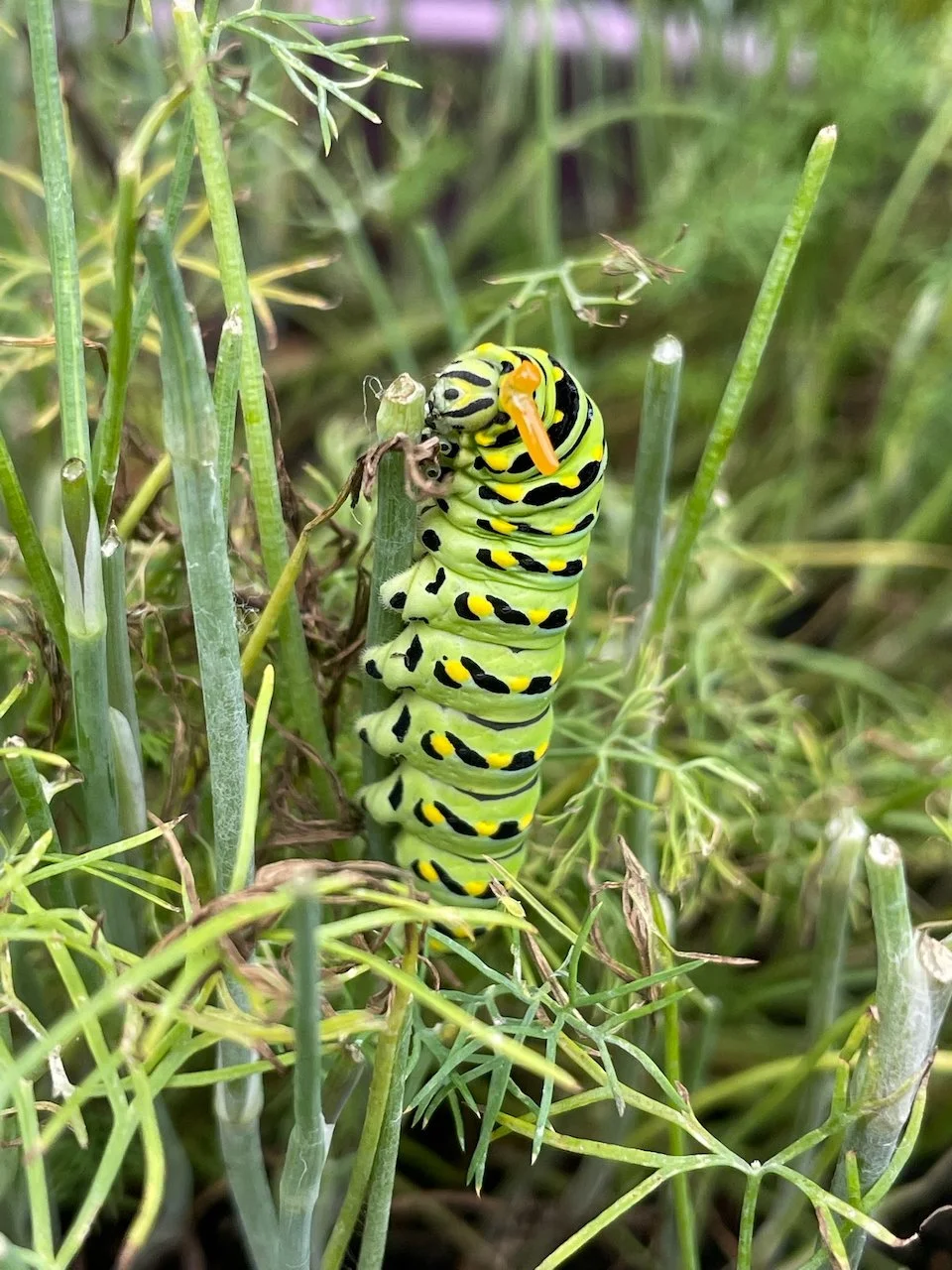Eastern Black Swallowtail
The Butterfly That Smells Like Trouble
In the quiet of a summer morning, you might catch a flicker of black and blue darting low across your garden beds. It’s not a shadow, it’s the Eastern Black Swallowtail (Papilio polyxenes), a native butterfly with a flair for drama and a taste for parsley or any other plant from the carrot family.
A Familiar Visitor with Many Names
Depending on who you ask, this butterfly might be called the Parsley Worm, the Caraway Swallowtail, or simply the Black Swallowtail.
It’s found across much of Canada, the eastern and midwestern U.S., and into northern Mexico. And while it’s common, it’s anything but ordinary.
(Photo: Mid-stage Black Swallowtail caterpillar eating parsley, showing bold green, black, and yellow stripes)
The Caterpillar with a Secret Weapon
Before it becomes a butterfly, the Eastern Black Swallowtail is a caterpillar with a curious defence: when threatened, it pops out a bright orange forked gland called an osmeterium. It smells awful, like a stink bomb in miniature, and it’s surprisingly effective at keeping predators at bay.
Young caterpillars start out disguised as bird droppings (yes, really), then transform into bold green-and-black striped larvae with yellow spots. They feed on plants in the carrot family, like parsley, dill, fennel, and native species like Golden Alexander (Zizia aurea) and Wild Licorice (Osmorhiza longistylis).
A Butterfly of Many Habitats
Eastern Black Swallowtails thrive in open spaces: wet prairies, roadsides, gardens, and even weedy patches that most people overlook. They’re fast flyers, zigzagging through the air to avoid birds and bats. Males are smaller, with bright yellow spots; females are larger, with more blue on their wings, a subtle but striking difference.
From Egg to Flight
A single female can lay over 400 eggs, each one carefully placed on a host plant. The eggs start pale yellow and darken before hatching.
After a few weeks of munching and moulting, the caterpillar forms a chrysalis, green or brown, depending their surrounding and on the season. Some emerge in two weeks; the last season’s caterpillars overwinter, waiting until spring to complete their transformation.
When the adult butterfly finally emerges, it rests for hours, pumping fluid into its wings before taking its first flight. Its life as a butterfly is brief, just a week or two, but in that time, it pollinates native flowers like Wild Bergamot (Monarda fistulosa), Swamp Milkweed (Asclepias incarnata), and Joe-Pye Weed (Eutrochium maculatum).






Sharing Space with a Native Pollinator
If you grow herbs, you may already be hosting Eastern Black Swallowtails. Before harvesting parsley or dill, check for eggs and caterpillars. If you find one, consider leaving that plant a little longer, or gently moving the caterpillar to another host nearby.
These butterflies remind us that even the most familiar garden visitors have stories worth telling. They’re not just pretty wings. They’re part of a larger web, connecting native plants, pollinators, and people.
With wings expanded and drying in the sun, this Swallowtail granted one last pose.
Native Host Plants
Golden Alexander (Zizia aurea)
Wild Licorice (Osmorhiza longistylis)
Stiff Cowbane (Oxypolis rigidior)
Canadian Honewort (Cryptotaenia canadensis)
Heart Leaved Alexander (Zizia aptera)
Purple Meadow Parsnip (Thaspium trifoliatum)
Purplestem Angelica (Angelica atropurpurea)
Excellent Native Nectar Sources for the Eastern Black Swallowtail Butterfly
Common Milkweed (Asclepias syriaca)
Swamp Milkweed (Asclepias incarnata)
Swamp Thistle (Cirsium muticum)
Wild Bergamot (Monarda fistulosa)
Scarlet Bee Balm (Monarda didyma)
Spotted Joe – Pye Weed (Eutrochium maculatum)
Sweet Joe Pye Weed (Eupatorium purpureum)
Ironweed (Vernonia noveboracensis)
Rose Swamp Mallow (Hibiscus moscheutos)
Button Bush (Cephalanthus occidentalis)
Dense Blazing Star (Liatris spicata)
Fun Facts for Budding Naturalists
🧙♂️ Caterpillar’s Magic Trick
When a Black Swallowtail caterpillar feels threatened, it pops out a bright orange “Y”-shaped organ from behind its head called an osmeterium. It looks like a tiny snake tongue and smells super stinky, like a bug’s version of a stink bomb!
🍝 The Pasta-Loving Butterfly Their caterpillars are nicknamed “parsley worms” because they love munching on parsley, dill, fennel, and even celery. Basically, they’re the butterfly world’s biggest fans of spaghetti herbs!
🎭 Masters of Disguise Young caterpillars look like bird poop. Yep, you read that right! It’s their way of saying, “Nothing tasty here, move along!”
🎨 Boys vs. Girls: The Wing-Off Male Black Swallowtails wear bright yellow spots like flashy jewelry, while females go for a cool blue shimmer. It’s like a butterfly fashion show!
🦋 Butterfly Gymnastics These butterflies are speedy flyers and love to zip low to the ground. If butterflies had the Olympics, Black Swallowtails would totally win the floor routine.

